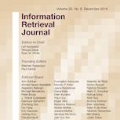Modern IR systems are increasingly tasked with answering complex, multi-faceted queries that require deep reasoning rather than simple keyword or semantic matching. While LLM-based IR has shown great promise, the prevailing retrieve-then-rerank paradigm inherits the limitations of embedding-based retrieval; parametric generative approaches are difficult to update with new information; and long-context methods that place the entire corpus in context are computationally infeasible for large document collections. To address these challenges, we introduce LATTICE, a hierarchical retrieval framework that enables an LLM to reason over and navigate large corpora with logarithmic search complexity by imposing a semantic tree structure on the corpus. Our approach consists of two stages: (1) an offline phase that organizes the corpus into a semantic hierarchy via either a bottom-up agglomerative strategy or a top-down divisive strategy using multi-level summaries and (2) an online traversal phase where a search LLM navigates this tree. A central challenge in such LLM-guided search is that the model's relevance judgments are noisy, context-dependent, and unaware of the hierarchy, making cross-branch and cross-level comparisons difficult. To overcome this, we propose a traversal algorithm that estimates calibrated latent relevance scores from local LLM outputs and aggregates them into a global path relevance metric. Our training-free framework achieves state-of-the-art zero-shot performance on the reasoning-intensive BRIGHT benchmark, demonstrating up to 9% improvement in Recall@100 and 5% in nDCG@10 over the next best zero-shot baseline. Furthermore, compared to the fine-tuned SOTA method DIVER-v2, LATTICE attains comparable results on BRIGHT subsets that use a static corpus for evaluation.
翻译:暂无翻译



